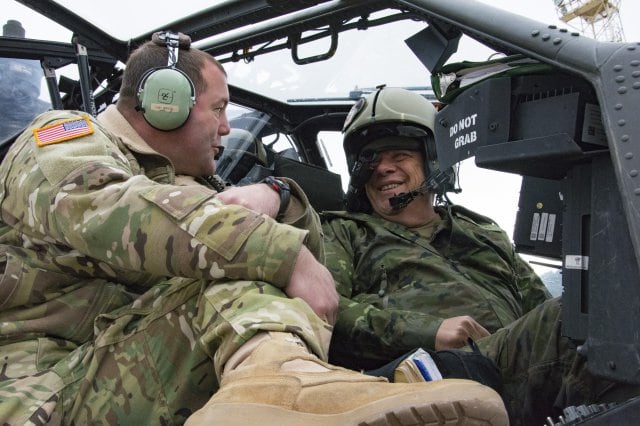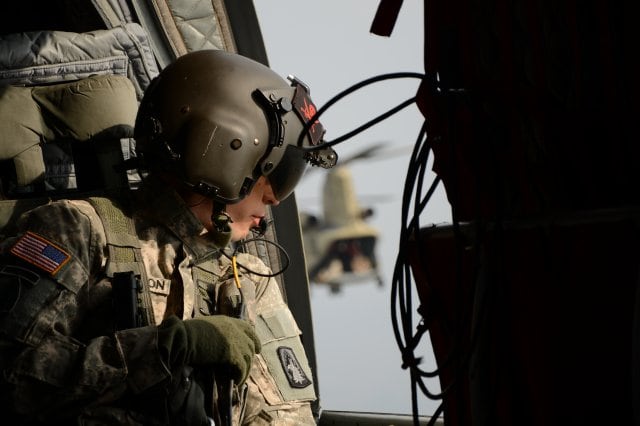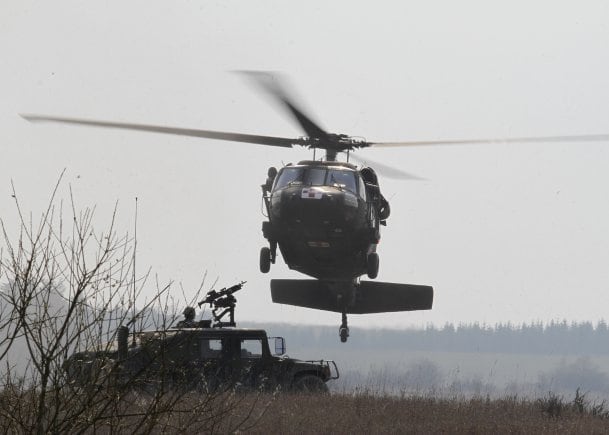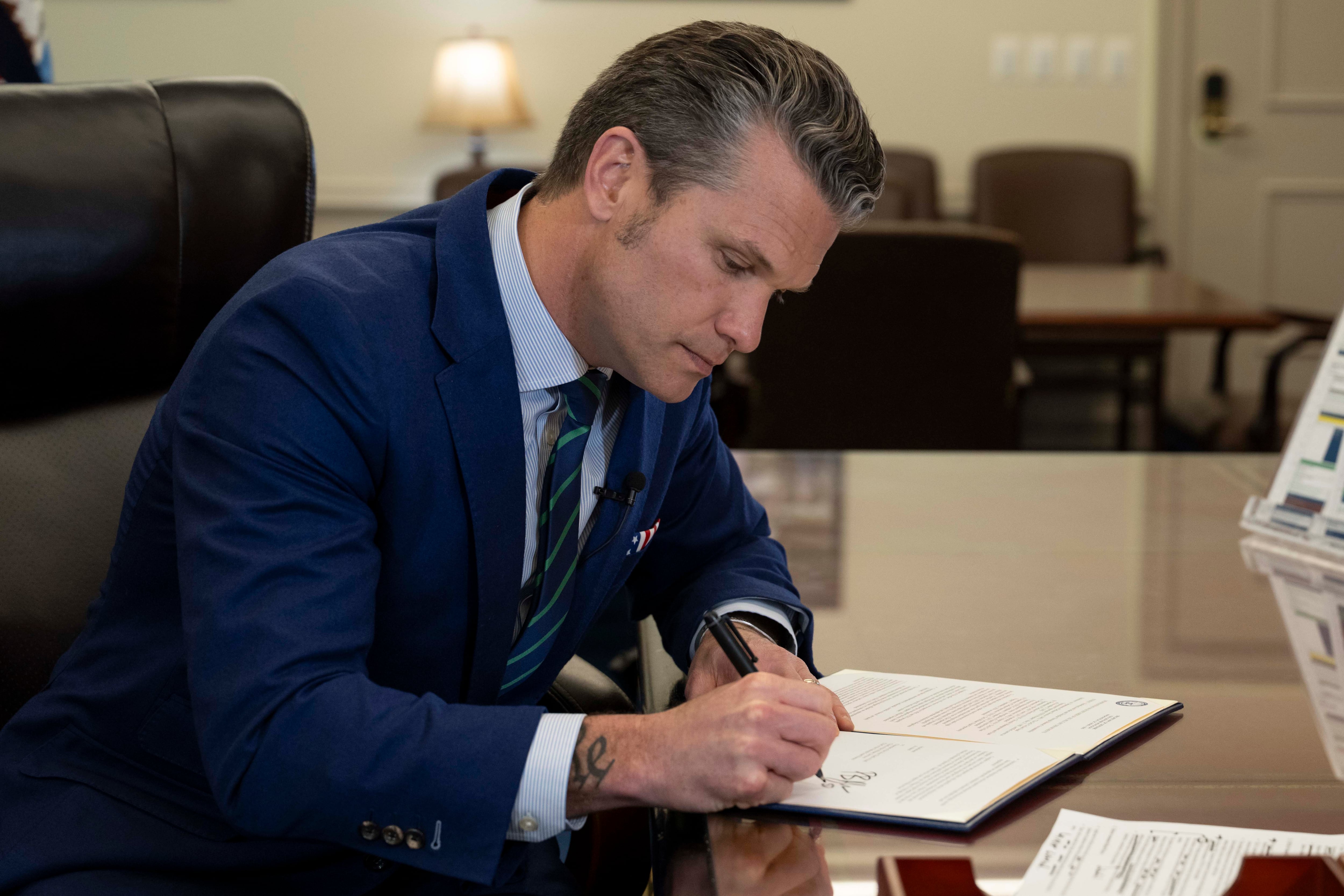Army leaders in Europe are asking for more rotational helicopters and aviators to fill an "aviation deficit" as the service shrinks its sole combat aviation brigade in the region.
"We have less capability than we had before," said Col. Chris Waters, commander of the 12th CAB, during a meeting with reporters Tuesday in the Pentagon. "In my assessment, that has created an aviation deficit in [U.S. European Command] for rotary wing capability."
As a result, "we're struggling to build readiness," he said.
The combat aviation brigade is the Army's primary aviation formation, and it is home to attack, medium lift, heavy lift and medevac helicopters, and unmanned aerial systems. When deployed, a CAB can deploy deadly Apache helicopters against the enemy, move troops across the battlefield, or ferry the wounded to safety. The CAB also can flex to support humanitarian assistance missions, and it can provide valuable reconnaissance across the battlefield. In Europe, aviation soldiers support training missions and participate in events such as air shows and parades to support NATO partner nations.
The Army has been sending a scaled down assault battalion to Europe on a rotational basis to make up for the troop and aircraft cuts in the brigade.
Soldiers from 4th Battalion, 3rd Aviation Regiment in mid-November completed their nine-month rotation to Europe and returned to Fort Stewart, Georgia. The unit, which was the first rotational aviation task force in Europe, was replaced by 3rd Battalion, 227th Aviation Regiment. That unit belongs to the 1st Air Cavalry Brigade at Fort Hood, Texas.
But that's not enough, Waters said.
For the next rotation, which is scheduled for the August 2016 time frame, U.S. Army Europe is working on a request for forces that would boost the size and capability of the rotational force, Waters said.
Commanders are asking for a full assault battalion, an attack battalion, portions of a general support aviation battalion, and the accompanying enablers, he said.
"What we're asking for in the next request for forces is to bolster that capability to more than just an assault battalion-minus," he said. "We're working diligently to ensure the Army understands what requirements we need."

Chief Warrant Officer 3 Shawn Bryan, an Apache pilot 12th Combat Aviation Brigade, gives an explanation of the Apache's instruments to Spanish Lt. Gen. Rafael Comas during Exercise Trident Juncture in Zaragoza, Spain, Nov. 3.
Photo Credit: Capt. Jaymon Bell/Army
The 12th CAB, based in Ansbach, Germany, is being reorganized from a brigade with seven battalions – the Army's largest – to a much smaller headquarters element as part of the Army's five-year Aviation Restructuring Initiative.
The move, which is almost complete, brings the brigade from nearly 4,000 soldiers assigned to an eventual steady state of about 1,000 soldiers. The plan is to augment the 12th CAB with rotational aviation units from the U.S.
The reorganization is part of a larger Army plan to draw down the force amid shrinking budgets.
But the cuts also come as the U.S. works to reassure its European allies in the face of Russian aggression.
The continuing turmoil in Syria and the resulting refugee crisis also add strain to the region, Waters said.
"While the Army had to make decisions to restructure, the environment changed," he said.
A key part of the U.S. effort to reassure its allies in the region is Operation Atlantic Resolve, a series of exercises and continuing engagements across the continent. Over the last nine months, the 12th CAB has trained with NATO forces and conducted operations in Germany, Poland, Lithuania, Latvia and Estonia. The soldiers also operated alongside Bulgarian, Romanian and Italian troops.
In fiscal year 2015, Army Europe conducted 51 exercises, and almost all of them asked for helicopter support, Waters said.
While his soldiers are getting good training – Europe is "a tremendous operating environment, a trying and demanding aviation environment," Waters said – the Army's aviation assets are stretched thin, he said.

Sgt. Austin Anderson, a CH-47 helicopter repairer for the 12th Combat Aviation Brigade, serves as a crew chief during the exchange of the Chinook helicopters at Bremerhaven, Germany, Aug. 21, 2015.
Photo Credit: Spc. Nicholas Redding/Army
Since the restructuring of the 12th CAB was announced in April, the Army has moved quickly to implement the changes. The brigade used to have seven organic battalions; it now has two, Waters said.
"We effectively lost five battalions," he said.
Three battalions were deactivated, and two others were moved – an attack battalion went to Alaska, and an airfield operations battalion went to Fort Bragg, North Carolina.
What remains in Europe is an attack battalion, which has been reflagged and aligned with the 3rd Infantry Division's aviation brigade. The battalion, 1-3 Attack Reconnaissance Battalion, is currently organic to the 12th CAB, Waters said, but long-term plans call for it to eventually be moved to Fort Stewart and Hunter Army Airfield in Georgia.
The 12th CAB also retained part of a CH-47 Chinook company, and a modified general support aviation battalion, Waters said.
In effect, the 12th CAB went from having 48 AH-64 Apache helicopters to now having 24, Waters said.
The brigade lost 30 assault UH-60 Black Hawks and four of its 12 CH-47 Chinooks. It went from 20 command and control Black Hawks to just 10, and from 30 medevac helicopters to just six.
"I don't expect that we're going to get force structure back in the near future," Waters said.

A UH-60 Black Hawk helicopter assigned to U.S. Army Europe's 12th Combat Aviation Brigade searches for a landing spot to pick up mock wounded soldiers during a Combined Arms Live-Fire Exercise at the Grafenwoehr (Germany) Training Area.
Photo Credit: Spc. Glenn M. Anderson/Army
The brigade is unable to support the volume and capacity it used to, and it relies more heavily on Army Europe for logistics support and depot-level maintenance.
"From an operational and capability perspective, we cannot build readiness," Waters said. "Where most missions would ask for companies of aircraft, we would put platoons against it. Where they ask for platoons, we put a single ship. The most important aspect of our mission is presence, so an air show in London or the Lithuanian national military day parade, a Black Hawk or Apache is effective. Where we miss out is our ability to conduct collective training."
To make up for that loss, the brigade has relied on rotational aviation units.
"U.S. Army Europe has well documented the requirements we have for aviation," Waters said. "And since the restructuring initiatives took organic capability away, how we expect to address that deficit is through rotational units."
Even stretched, his soldiers, as well as those rotating into the region, are getting tough, realistic training, as well as ample opportunity for junior leaders to stretch and develop their abilities, Waters said.
"There's no finer operating environment right now in the Army for young leaders to be out, away from the flag pole, giving guidance and conducting training," he said.
Michelle Tan is the editor of Army Times and Air Force Times. She has covered the military for Military Times since 2005, and has embedded with U.S. troops in Iraq, Afghanistan, Kuwait, Haiti, Gabon and the Horn of Africa.





